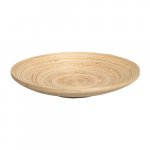I several times make the claim that the direct sound is an error and must be eliminated !
What do You think Elias - how much of it should be eliminated? surely a pillow is a low pass filter
can You post any frequency measurements of pillow effect - what part of the spectrum of direct sound is muted and how much?
Have You tried the Brociner deflector option (like Radugazon's half-waveguide type)?
You can use various types of deflecting things for instance various bamboo bowls
... some side firing systems fitted with a lot of CD drivers and symmetric reflecting surfaces can have accurate details with very good imaging.
Yeah, CD radiation and controlled reflections would be a minimum requirement IMHO. But I can't yet see how to keep enough symmetry when leaving the stereo axis (stepping to the side for instance). If two-channel localisation cues are altered by >3 dB or > 0.25 ms because of radiation/reflection non-symmetry, the stereo scene might get distorted severely.
Yeah, CD radiation and controlled reflections would be a minimum requirement IMHO. But I can't yet see how to keep enough symmetry when leaving the stereo axis (stepping to the side for instance). If two-channel localisation cues are altered by >3 dB or > 0.25 ms because of radiation/reflection non-symmetry, the stereo scene might get distorted severely.
There is no focused imaging like in 60° stereo. Nowhere near. But the added spaciousness doesn't make it sound confusing like when there's too much reverberation. It just sounds very natural which is the key. Listen with closed eyes in different environments to real sound sources, you won't experience pin-point localization like in stereo.
The room has to be treated too otherwise a center bipole will just sound horrible with all that exessive reverberation going on.
Yeah, CD radiation and controlled reflections would be a minimum requirement IMHO. But I can't yet see how to keep enough symmetry when leaving the stereo axis (stepping to the side for instance). If two-channel localisation cues are altered by >3 dB or > 0.25 ms because of radiation/reflection non-symmetry, the stereo scene might get distorted severely.
intuitively I would say - yes, You are right
but experience contradicts this intuition, my own and also Radugazon's for instance:
Now the sound :
Some informations can be identified as coming from the walls, but not very often (if not so it’s a big trouble). Mostly the virtual sources are between, in the no speaker/no wall zone, and they are stable. More, they are where they have to be.
(...)
- The sweet spot is very wide, at 2.50m, at least 3 people could seat side to side. They can turn the head, nothing changes.
Listening this will then be listening :
- imaging is more contrasted, stable
(...)- the listening spot is almost anywhere except in the waves guides axis
best,
graaf
Last edited:
I seldom listen to a real concert with closed eyes. And I seldom listen to recordings with eyes open.  I believe (for myself) in the need for more precise localization in recordings due to the absence of ventriloquism.
I believe (for myself) in the need for more precise localization in recordings due to the absence of ventriloquism.
My career as a listener to music started as a boy at home with most family members playing an instrument or singing. Sitting in row 20 at a concert was felt as a degraded listening experience. I'm the one who finds the AB configuration in the Schoeps piano example the least interesting. That's not how I experience a piano when standing at 2 m distance. It is a distributed instrument then and not a point source.
I'm the one who finds the AB configuration in the Schoeps piano example the least interesting. That's not how I experience a piano when standing at 2 m distance. It is a distributed instrument then and not a point source. 
I have to believe that graaf's "palpable, robust quality of phantom images" is way off from what I look for. And his remark "You can get imaging as precise as in the case of triangular stereo" simply reminds me of the fact, that some people have not stepped very high on the ladder of triangular stereo yet.
This is just to show how different views on the same subject can be. I'd wish that some of us could express their statements more as "beliefs" and less as "truth". It would make it easier for me to find out what has alreadfy been achieved and what is wishful thinking.
My career as a listener to music started as a boy at home with most family members playing an instrument or singing. Sitting in row 20 at a concert was felt as a degraded listening experience.
I have to believe that graaf's "palpable, robust quality of phantom images" is way off from what I look for. And his remark "You can get imaging as precise as in the case of triangular stereo" simply reminds me of the fact, that some people have not stepped very high on the ladder of triangular stereo yet.
This is just to show how different views on the same subject can be. I'd wish that some of us could express their statements more as "beliefs" and less as "truth". It would make it easier for me to find out what has alreadfy been achieved and what is wishful thinking.
There is no focused imaging like in 60° stereo. Nowhere near. But the added spaciousness doesn't make it sound confusing like when there's too much reverberation. It just sounds very natural which is the key. Listen with closed eyes in different environments to real sound sources, you won't experience pin-point localization like in stereo.
Uh oh, someone is starting sound a lot like me.
Last edited:
Uh oh, someone is starting sound a lot like me.

You're thinking of at least 5 CD speakers at the front too?
You're thinking of at least 5 CD speakers at the front too?
and what about Stereosphere? Have You abandoned this promising project?
I'd wish that some of us could express their statements more as "beliefs" and less as "truth". It would make it easier for me to find out what has alreadfy been achieved and what is wishful thinking.
for my part I just present true statements with regards to what I have experienced. I assume the same about such statements from all other participants in this thread - Elias, Radugazon, ScottG, Markus, Rudolf, Pelanj, el`Ol and all others - that they are true in this sense - honest
I am sorry Rudolf but suggesting that any of us is making up and presenting Her/His wishful thinking instead of actual experience I consider simply disrespectful
read again what people have written, for instance Radugazon's observations that I have recently quoted, and think again
regards,
graaf
You're thinking of at least 5 CD speakers at the front too?
CD as in "constant directivity"?
Possibly.. it depends on how it's implemented. If you are thinking waveguide then think again.
BTW, I'm still not sure how those 5" drivers in the Stereolith are providing that much output at 90 degrees (from driver 0). It just *looks* wrong. Still, in case no one has said it before regarding the measurements: THANK YOU!
CD as in "constant directivity"?
Yes.
BTW, I'm still not sure how those 5" drivers in the Stereolith are providing that much output at 90 degrees (from driver 0). It just *looks* wrong. Still, in case no one has said it before regarding the measurements: THANK YOU!
Actually they're 4.3"
Get out your old cardboard boxes and measure. There's way too much speculation going on in this thread. I'd like to see more hard facts.
I'd like to see more hard facts.
actually at least Elias and Radugazon have presented a lot of hard facts recently - with measurements, diagrams and pictures
Show us some hard facts about Stereosphere please
Last edited:
Actually they're 4.3"
Get out your old cardboard boxes and measure. There's way too much speculation going on in this thread. I'd like to see more hard facts.
I've mentioned before (in this thread), I don't currently have that capability.
As for speculation..
The manufacturer lists the driver as 13cm, or in the states what we would refer to as a 5.25" driver.. NOT that the driver's diaphragm is 5.25" but rather the total diameter of the driver is *roughly* 5.25".
As I've mentioned before, I don't currently have access to measuring equipment or even the smaller driver's I've used in similar experiments.
What I have seen however is:
1. manufacturer data on all sorts of "5.25" inch drivers. (..and in many cases extending to 60 degrees off-axis - which of course exhibits *less* pressure loss than at 90 degrees (..depending on combing)).
2. Elias's measurements with a MUCH smaller diameter driver and measurements that are NOT nearfield (post 437).
3. Your own measurements (post 326).
I should have specified that it's the plot in post 569 that looks "off". Only a 10 db reduction at 7 kHz from the driver's 0 degree axis to its 90 degree axis at 1 meter. That IMO is extraordinary, and while it's extraordinariness is indeed speculation - it's also based on these facts.
Last edited:
To summarize , dual channel Side Firing and Front Firing have the same goal, but with different ways.
The FF will do it's best to privilegiate the direct sound, but with perturbations caused by all the reflections and the necessity to create valid phantom images.
The issue is that without the reflections participation the soundstage will stay confined between the speakers.
The SF with unique central speaker will use mostly the reflected field, but then, with poor designs, the phantom image can be concentrated in the middle, or, not better, can obviously come from each wall virtual source. Great job then, the defaults of the ordinary FF are emulated without it's counter part of greater details.
None of these strategies is perfect. Each has to create a sound source from nowhere : between and outside the speakers for the FF, between the walls and the speaker for SF.
A third but not so different approach is the utilisation of totally omni sources, as the MBL (could it be in Beveridge situation, it's always a dual source in triangle), or almost omni polarized sources (as linear quadripoles) with a SF pattern accentuation.
Correst me if I'm wrong, but do you see an absolutely great fundamental difference between these options ? When we get something "OMG amazing!" it's not because of the speakers particular virtues, but only because our hearing processes can be easily abused.
The FF will do it's best to privilegiate the direct sound, but with perturbations caused by all the reflections and the necessity to create valid phantom images.
The issue is that without the reflections participation the soundstage will stay confined between the speakers.
The SF with unique central speaker will use mostly the reflected field, but then, with poor designs, the phantom image can be concentrated in the middle, or, not better, can obviously come from each wall virtual source. Great job then, the defaults of the ordinary FF are emulated without it's counter part of greater details.
None of these strategies is perfect. Each has to create a sound source from nowhere : between and outside the speakers for the FF, between the walls and the speaker for SF.
A third but not so different approach is the utilisation of totally omni sources, as the MBL (could it be in Beveridge situation, it's always a dual source in triangle), or almost omni polarized sources (as linear quadripoles) with a SF pattern accentuation.
Correst me if I'm wrong, but do you see an absolutely great fundamental difference between these options ? When we get something "OMG amazing!" it's not because of the speakers particular virtues, but only because our hearing processes can be easily abused.
All this being said, the front and back SF sources start to produce some nice sensations. We can found some premisses more 40 years ago, through Hafler and Gerzon, but none of them was using two SF sources together.
Actually, I have changed the pattern of the rear speaker to match the pattern of the main front speakers. I feel it's better, and confirmation : the binaural impulse record shows more asymmetry L/R. It's not very readable in the Wavelets plots (normalization issues ?) but it appears better in the corresponding spectrogram.
It's also an occasion to compare the two representations.
Actually, I have changed the pattern of the rear speaker to match the pattern of the main front speakers. I feel it's better, and confirmation : the binaural impulse record shows more asymmetry L/R. It's not very readable in the Wavelets plots (normalization issues ?) but it appears better in the corresponding spectrogram.
It's also an occasion to compare the two representations.
Attachments
We can found some premisses more 40 years ago, through Hafler and Gerzon, but none of them was using two SF sources together.
I can see that You are still investigating the CTC hypothesis, am I correct?
Actually, I have changed the pattern of the rear speaker to match the pattern of the main front speakers.
what exactly have You done that changed the pattern of the rear speaker? Have You added the delays?
The issue is that without the reflections participation the soundstage will stay confined between the speakers.
plus head-in-a-vise - especially obvious in direct comparison with SF
When we get something "OMG amazing!" it's not because of the speakers particular virtues, but only because our hearing processes can be easily abused.
well, but isn't this abuse the very virtue of the speaker system?
A third but not so different approach is the utilisation of totally omni sources, as the MBL (could it be in Beveridge situation, it's always a dual source in triangle), or almost omni polarized sources (as linear quadripoles) with a SF pattern accentuation.
and a flooder...
can it be a kind of via media?
Correst me if I'm wrong, but do you see an absolutely great fundamental difference between these options ?
You tell me -would You go the way from Your actual bipolar stereo setup via OSD via various dipoles back to the conventional front firing speakers in a stereo triangle? Would You?
Last edited:
CTC ? For sure I would like to achieve a little result without processor. Now I have to try the real Hafler wiring.
Changing the radiation pattern? Easy, it's just removing the WG, and for the delays, it's the distance between the two groups and the seat that's variable.
About head in a clamp, I have the same obligation if I want to stay in the point where the impulses converge. But it's not sure that the sound is like this absolutely better on all records.
The very virtue : you are right, what I wanted to say that the great result depends more of the software (the set up...) than of the hardware. Ok, not a very good explanation again, but you see what I mean.
Flooder : sorry, I forget systematically : never seen and never done. So, no valuable opinion.
The last question is absolutely ... hum. Following my journey in the speaker DIY, I confess that it's much easier to get spaciousness, then imaging with a little work, then envelopment with more work...... if starting from a side firing base.
The same level of illusion with a front firing requires much more talent from the designer.
Changing the radiation pattern? Easy, it's just removing the WG, and for the delays, it's the distance between the two groups and the seat that's variable.
About head in a clamp, I have the same obligation if I want to stay in the point where the impulses converge. But it's not sure that the sound is like this absolutely better on all records.
The very virtue : you are right, what I wanted to say that the great result depends more of the software (the set up...) than of the hardware. Ok, not a very good explanation again, but you see what I mean.
Flooder : sorry, I forget systematically : never seen and never done. So, no valuable opinion.
The last question is absolutely ... hum. Following my journey in the speaker DIY, I confess that it's much easier to get spaciousness, then imaging with a little work, then envelopment with more work...... if starting from a side firing base.
The same level of illusion with a front firing requires much more talent from the designer.
never seen and never done.
You're not the only one. I also haven't seen anything tangible.
Last edited:
- Home
- Loudspeakers
- Multi-Way
- Stereolith Loudspeakers Question




